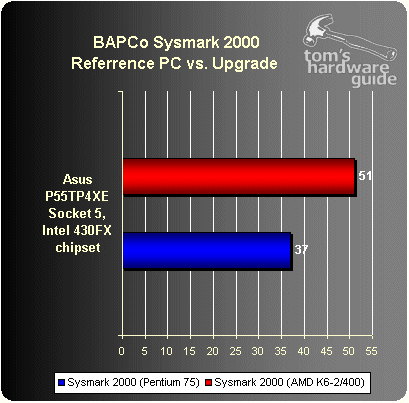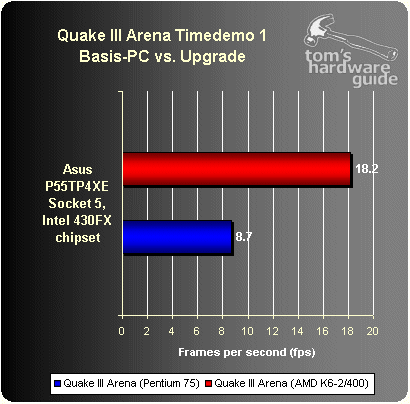Socket 5: Tuning Old PC Systems
Test Setup
| Hardware | |
|---|---|
| Processors | Intel Pentium 75 MHzAMD K6-2/400 |
| L2 Cache Clock | 66 MHz |
| System Bus Clock | 50 or 66 MHz |
| Memory Clock | 66 MHz |
| Memory | IBM SIMM 48 MB 16 ns |
| Motherboards | ASUS P55TP4XE, Rev. 2.1Bios 14/02/1997 |
| Graphics Card | NVIDIA Riva 128, PCIWin98 default drivers |
| Sound | Creative Soundblaster 64 |
| Network | 3COM 3C905B-TX, 100 MBit/s |
| Hard Disk | Maxtor 850 MB |
| Software & Settings | |
| OS Version | Windows 98 SE, Service Pack 1 |
| Screen Resolution | 1024 x 768 x 16 x 85 |
| SYSmark 2000 | Version 1.0, Patch 4 |
| Quake III Arena | Timedemo 1 |
Performance Comparison: Basic Model Vs. Tuning
To measure performance, we used the Sysmark 2000 application benchmark from BAPCo as well as the Timedemo1 from the well-known Quake III Arena games benchmark. Both test procedures clearly prove that the total system performance increases considerably by using the fast AMD-CPU in conjunction with the memory upgrade. Originally the processor bus clock of a Pentium 75 is 50 MHz. It is then increased to 66 MHz for an AMD K6-2/400. This influences the overall performance significantly. The L2 cache and the memory are also automatically clocked at a faster rate by increasing the processor bus clock. It's just rather annoying that the processor bus clock for the Intel 430FX chipset can only be adjusted to 66 MHz. Further increase of the processor bus clock to 75 MHz or even 83 MHz (as is offered by some boards with a 430HX chipset) would facilitate a processor core clock of 450 MHz or 500 MHz! And all this on a platform that is more than six years old.
Get Tom's Hardware's best news and in-depth reviews, straight to your inbox.
Current page: Test Setup
Prev Page Upgrade 2: Suitable Motherboards Next Page Conclusion: Powerful Performance Injection For Socket 5 Boards
